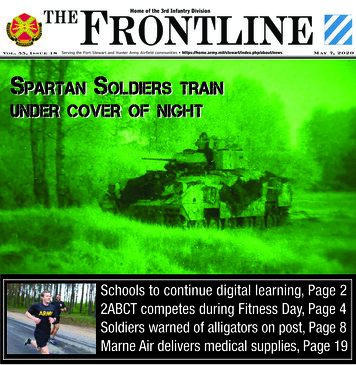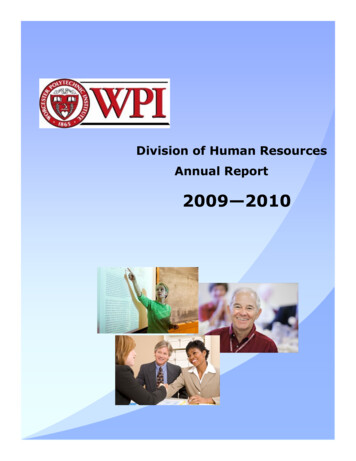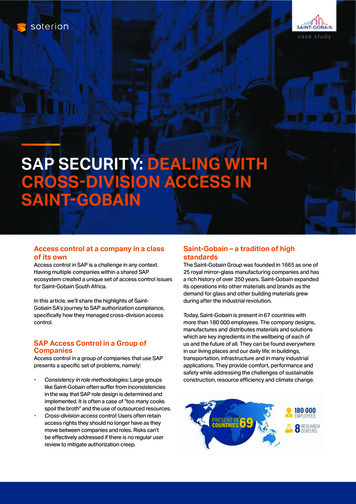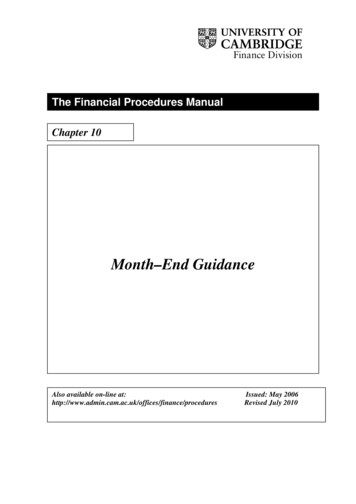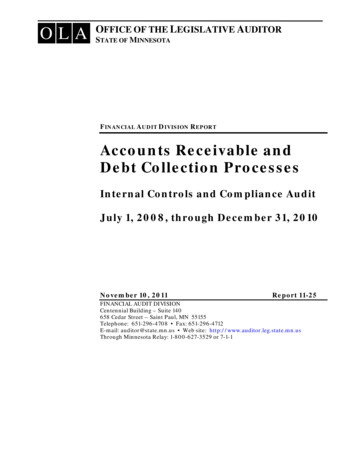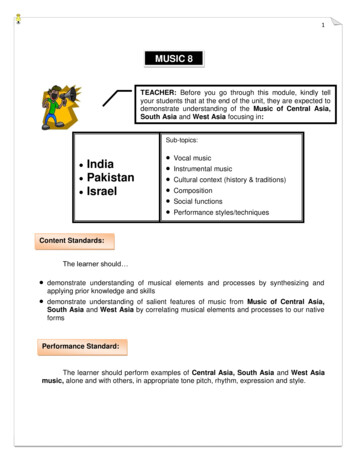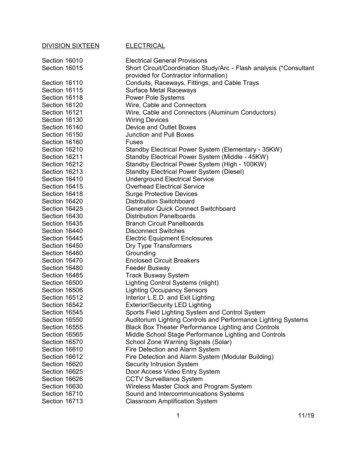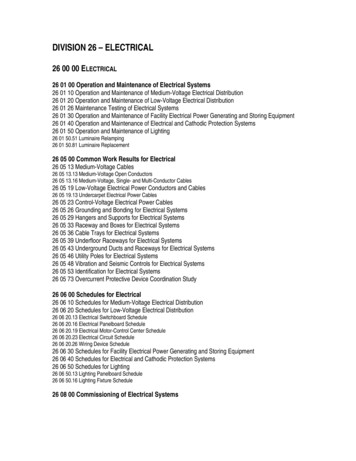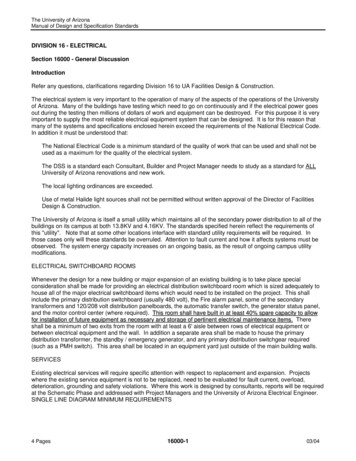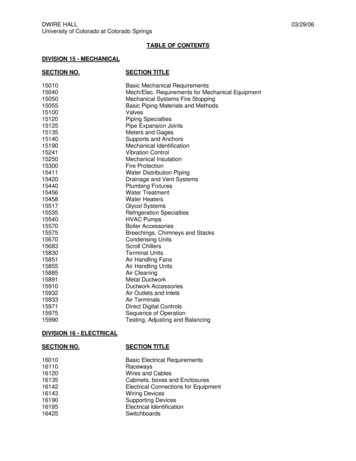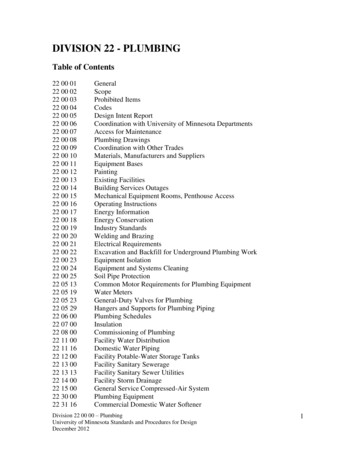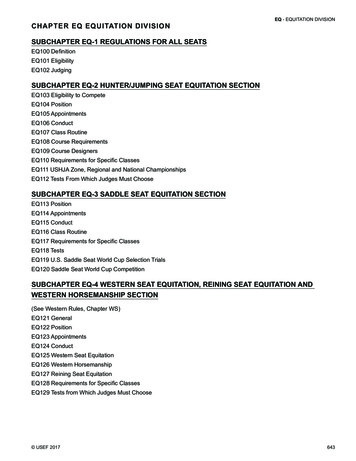
Transcription
CHAPTER EQ EQUITATION DIVISIONEQ - EQUITATION DIVISIONSUBCHAPTER EQ-1 REGULATIONS FOR ALL SEATSEQ100 DefinitionEQ101 EligibilityEQ102 JudgingSUBCHAPTER EQ-2 HUNTER/JUMPING SEAT EQUITATION SECTIONEQ103 Eligibility to CompeteEQ104 PositionEQ105 AppointmentsEQ106 ConductEQ107 Class RoutineEQ108 Course RequirementsEQ109 Course DesignersEQ110 Requirements for Specific ClassesEQ111 USHJA Zone, Regional and National ChampionshipsEQ112 Tests From Which Judges Must ChooseSUBCHAPTER EQ-3 SADDLE SEAT EQUITATION SECTIONEQ113 PositionEQ114 AppointmentsEQ115 ConductEQ116 Class RoutineEQ117 Requirements for Specific ClassesEQ118 TestsEQ119 U.S. Saddle Seat World Cup Selection TrialsEQ120 Saddle Seat World Cup CompetitionSUBCHAPTER EQ-4 WESTERN SEAT EQUITATION, REINING SEAT EQUITATION ANDWESTERN HORSEMANSHIP SECTION(See Western Rules, Chapter WS)EQ121 GeneralEQ122 PositionEQ123 AppointmentsEQ124 ConductEQ125 Western Seat EquitationEQ126 Western HorsemanshipEQ127 Reining Seat EquitationEQ128 Requirements for Specific ClassesEQ129 Tests from Which Judges Must Choose USEF 2017643
EQ - EQUITATION DIVISIONCHAPTER EQ EQUITATION DIVISIONSUBCHAPTER EQ-1 REGULATIONS FOR ALL SEATSEQ100 DefinitionThe Equitation Division is divided into three sections: Hunter/Jumping, Saddle and Western Seats. Judges officiatingthese sections shall be licensed accordingly unless permitted in the rules of the specific Equitation Finals (Exception:GR1004.4). Separate classes can be offered for boys and girls; different age limits; or ribbons won. Dressage SeatEquitation is exempted from the requirements of Chapter EQ. For Dressage Seat Equitation, see DR133.EQ101 Eligibility1. Riders in classes for junior exhibitors cannot have reached their 18th birthday in accordance with GR127, however competitions are encouraged to offer Adult Equitation classes for amateur riders who have reached their 18thbirthday.2. In Equitation classes only the rider is being judged, therefore, any horse that is suitable for a particular style ofriding (i.e., Hunter/Jumping Seat, Saddle Seat or Western/Reining Seat) and is capable of performing the requiredclass routine is acceptable.3. Stallions are prohibited. (Exception: USEF Talent Search Class/Finals; Hunter Seat Equitation classes restricted toadults; classes restricted to a breed if division rules for the breed of horse ridden permit their use for juniors, and ifthe division rules for the breed of horse ridden permit juniors to ride stallions).4. Any rider competing and or riding anywhere on the competition grounds with their stirrup, stirrup leather, fender,or foot tied and/or secured in any manner will be eliminated from the entire competition. The steward will note thetrainer name(s) on the steward’s report, and further disciplinary actions may be taken by the Federation.5. Management shall not permit an animal to compete in any equitation class restricted to ponies or in any classwhere the pony’s height is a qualifying factor unless the person presenting the animal is in possession of a measurement card issued by the Federation or a copy of a valid measurement form.EQ102 Judging1. SOUNDNESS. Unsoundness does not penalize a competitor unless it is sufficiently severe to impair the requiredperformance. In such cases, the imposition of a penalty is at the judge’s discretion. (Exception: Hunter/JumpingSeat Equitation classes held at Hunter Jumper Competitions where, in a case of unsoundness sufficiently severe toimpair the required performance, the judge(s) must eliminate the competitor from that class and inform the competition manager, who in conjunction with the Official Veterinarian and the Steward, will evaluate disqualifying thehorse from further participation in the competition.) BOD 1/16/16 Effective 12/1/162. Any rider not having his mount under sufficient control will be dismissed from the ring and disqualified from that class.3. Riders must remain on the same mount throughout all phases of a class until the judge requests a change.4. No rider can be asked to perform a test on another horse before he has performed the same test on his own.5. Attendants are not allowed in the ring except at the request of judge(s).6. When additional tests are desired, the judges’ instructions to riders are publicly announced. It is suggested thatthe judge go over these instructions with the announcer immediately before they are announced to assure mutualunderstanding of the wording. For testing in Hunter Seat Finals, when riders are called back collectively into thering without their trainers, they may be given a copy of the course. If the judge desires, the test may be written onthe course diagram.7. Judges cannot confer with riders individually during the line-up. (Exception: Verbal testing).8. At Federation licensed hunter and/or jumper competitions, judges may not adjudicate from the same location as thestarter, or from a place where competitors and/or trainers are permitted to congregate.644 USEF 2017
9. ELIMINATIONS.EQ - EQUITATION DIVISIONa. If eliminations for a class are separated from the final phase, the performance in each phase has equal consideration unless otherwise specified in the prize list or class specifications. (Exception: ASPCA HorsemanshipFinals.)b. The final phase will be conducted in the same manner as the elimination except a different course can be usedin the Hunter/Jumping Seat classes and different tests can be used in all classes.c. If a posted workout is to be used at a later time it should be publicly announced and should be posted near thein-gate before the workout is called.10. In Open Equitation and Medal Classes, horses may not be ridden by more than one rider per class or section ofthe class. (Exception: Saddle Seat Equitation and Tests requiring a change of horses.)11. In a work-off a rider may not jump or be required to jump any fence that is not in the original course, except verticals included in the original course may be jumped in the opposite direction provided the ground lines are correct.Jumps must be jumped in the original direction unless otherwise specified.SUBCHAPTER EQ-2 HUNTER/JUMPING SEAT EQUITATION SECTION.WHEN A SUBJECT IS NOT ADDRESSED IN THESE RULES, IT MUST BE ADDRESSED BY THE APPROPRIATECOMMITTEE AND THAT COMMITTEE’S INTERPRETATION WILL STAND AS THE RULE UNTIL THE NEXT YEARWHEN AN APPROPRIATE RULE CHANGE WILL BE SUBMITTED.EQ103 Eligibility to Compete1. In order to compete in any Hunter/Jumping Seat Equitation classes at licensed competitions as an exhibitor, rider,trainer, or his/her agent(s), a person must be an Active member of the United States Hunter Jumper Association,Inc., or pay a Show Pass fee to the United States Hunter Jumper Association, Inc. Exception: Local Competitionsand ex ceptions listed in GR901.9. Exception: Breed restricted Hunter/Jumping Seat Equitation classes.2. USHJA Horse Registrations.a. All horses competing in Federation licensed and/or USHJA sanctioned competitions with Hunter, HunterBreeding, Jumper and Hunter/Jumping Seat Equitation classes not restricted by breed must be properly identifiedin accordance with GR1101, and must also be registered with USHJA (See GR1101.1). The USEF/USHJA registration number for each horse must be entered on all entry forms for licensed competitions.b. Applications for USHJA Registration can be completed online at ushja.org or usef.org using the USEF HorseRegistration application form. This form is also available from the USHJA or Federation office, as a download fromthe USHJA or Federation website or from competition management. Com petition management is responsible fornotifying exhibitors of this requirement in their prize list.3.1 In addition to the provisions of EQ103.2, on or after December 1, 2017, all horses competing in classes thatrequire USHJA horse registration must provide a microchip number that verifies their animal’s identity in order tocompete for points, money won or be eligible for Federation and/or USHJA programs and awards where horses arerequired to be recorded or registered.3.2 A microchip used to verify identity must be a fifteen digit ISO compliant 11784/11785 chip and be implanted in thenuchal ligament of the animal.3.3 For classes that require age verification, age can be verified only through the following identification documents:a. registration papers or passport issued by a World Breed Federation Sport Horse (WBFSH) recognized registry.b. registration papers or Certificate of Pedigree from a breed or sport horse registry.3.4 This rule will have a transition period from December 1, 2017 to November 30, 2018. During this period, animalsthat are not in compliance with this rule will not receive points or be eligible for Federation and/or USHJA programsand awards. After this period, all horses that are competing in classes which require USHJA registration which are not USEF 2017645
EQ - EQUITATION DIVISIONmicrochipped will be ineligible to compete in Federation licensed competitions. BOD 1/16/16 Effective 12/1/164. Adults can ride ponies in Adult Hunter Seat Equitation classes, suitability to count; however, these ponies cannotcross enter into the rated Regular and Green Pony Hunt er sections at the same competition.EQ104 Position1. General. Rider should have a workmanlike appearance, seat and hands light and supple, conveying the impressionof complete control should any emergency arise. Exhibitors may ride side saddle in Adult Equitation classes but notin classes restricted to Juniors.2. Hands. Hands should be over and in front of horse’s withers, knuckles thirty degrees inside the vertical, handsslightly apart and making a straight line from horse’s mouth to rider’s elbow. Bight of reins may fall on either side.However, all reins must be picked up at the same time. When using two reins, the snaffle rein should be on theoutside while the curb rein is on the inside.3. Basic Position. The eyes should be up and shoulders back. Toes should be at an angle best suited to rider’s conformation: ankles flexed in, heels down, calf of leg in contact with horse and slightly behind girth. Iron should be onthe ball of the foot and must not be tied to the girth.4. Position in Motion. At the walk, sitting trot and canter, body should be a couple of degrees in front of the vertical;posting trot, inclined forward; galloping and jumping, same inclination as the posting trot.5. Mounting and Dismounting. To mount, take up reins in left hand and place hand on withers. Grasp stirrup leatherwith right hand and insert left foot in stirrup, toe in girth and mount. To dismount, rider may either step down or slidedown. The size of rider must be taken into consideration.EQ105 Appointments1. Protective headgear. All riders must wear protective headgear. See GR801.2. While competing in a class, if a rider’s chin strap becomes unfastened, the rider may stop, re-fasten the chin strap and continue his/her performancewithout penalty or elimination. A judge may, but is not required, to stop a rider and ask them to refasten a chinstrap which has become unfastened, again without penalty to the rider. Headgear must be free from non-traditionaladornment.646 USEF 2017
EQ - EQUITATION DIVISION2. Attire. Riders are required to wear conservatively colored coats (black, blue, green, grey or brown) which are freefrom adornment which in the judge’s opinion is overly distracting. Shirts must have a choker, similar collar or tie.Breeches may be buff, canary, tan, rust or white.3. Spurs, crops or bats are optional but if used must be a conservative color.4. Inappropriate attire. When management permits Hunter/Jumping Seat Equitation riders to ride without jackets, riders must wear traditional, short, or long-sleeved riding shirts with chokers or ties. Polo shirts and full chaps are notpermitted except in unjudged warm-up classes. Management or Judge may eliminate an exhibitor who is inappropriately attired.5. Tack.a. In Hunter Seat Equitation, snaffles, pelhams and full bridles, all with cavesson nose bands, are required. Judges may penalize, but may not eliminate, a horse or pony that competes in a snaffle, pelham or full bridle that isunconventional. Judges must eliminate a horse or pony that competes in an illegal bit or a noseband other thana cavesson. Illegal bits include, but are not limited to, two rings, three rings, gags (other than the hunter gag), etcetera. Illegal nosebands include, but are not limited to, drop, flash and figure eight nosebands.b. In Jumping Seat equitation, snaffles, pelhams, full bridles, gags, two ring or three ring bits are required. Judges may penalize, but may not eliminate, a horse or pony that competes in an snaffle, pelham, or full bridle thatis unconventional. Judges must eliminate a horse or pony that competes in an illegal bit or noseband. Legalnosebands include leather cavesson, flash and figure eight. Illegal nosebands include but are not limited to dropnosebands.c. Boots and conservative colored bandages are permitted. Type of saddle is optional. Martingales are permittedin classes over obstacles and in the jumping phase of classes requiring both jumping and flat work. Martingalesare not permitted on the flat in any class or phase unless class specifications allow their use. Changing of bitsbetween phases is permissible. BOD 1/16/16 Effective 12/1/166.When showing in the Hunter/Jumping Seat Equitation section it is recommended that riders use traditional stainlesssteel stirrup irons that promote proper position of the foot in the iron as well as a correct leg position. It is furtherrecommended that riders use stirrup irons that allow judges a clear and unobstructed view of the position of the footin the stirrup. Judges may not eliminate a rider for using a particular style of stirrup iron. (Exception: see EQ101.4)7. Electronic Communication Devices.a. No mounted exhibitor may wear or carry an electronic communication device (i.e., cellular telephone, pager,walkie talkie, etc.) while in the competition ring. The penalty for wearing or carrying a forbidden device if observed by the judge may be elimination from the class during which the device was worn or carried.b. Electronic communication devices used for purposes of coaching, etc., between competitors and individualsoutside the ring shall be prohibited in all classes.c. Exhibitors who have a chronic condition may apply for a Presidential Modification exempting them from the provisions of this rule in accordance with GR152. Riders may not use these devices in over fences classes.d. An exhibitor who has a chronic condition and has previously been granted at least one annual presidentialmodification related to the condition, may submit an application for approval of a special three-year presidentialmodification related to the same condition. The application must be accompanied by sufficient supporting documentation that the condition is unlikely to improve during the three-year period.8. A rider will be eliminated for competing with a tail wrap.EQ106 Conduct(See GR1210.1a -.1e)1. Classes for junior and senior riders can be combined.2. When entries warrant, it is recommended that competitions restrict Maiden, Novice, Limit and Intermediate riders to USEF 2017647
EQ - EQUITATION DIVISIONtheir respective categories.3. DIVISION OF CLASSES. In Hunter/Jumping Seat, if there are 40 or more entries at the beginning of the class, itmay be divided and run as two separate sections. All classes with 50 or more entries at the beginning of the classmust be divided and run as two separate sections with separate trophies and ribbons; for Hunter/Jumping Seat, a“California split” method, as defined in HU112.7, must be used if the class requires numerical scores. (Exception:Regional and Na tional Equitation Finals and all Equitation Classics) BOD 1/16/16 Effective 12/1/164. MONEY PRIZES. In Equitation classes the rider is the competitor and wins the award. Offering of prize money inEquitation classes for junior exhibitors and ama teurs is forbidden. (Exception: Scholarship funds may be awarded.However, these funds must be disbursed directly to the institution upon proof of enrollment by the awarded recipient.)5. RIBBONS. In Hunt er/Jumping Seat Equitation classes a minimum of six ribbons must be awarded but no more thanten ribbons are required.6. NUMBERS. Numbers must be worn on the rider’s back and must be clearly visible at all times when in competition.7. Attention getting devices and/or other noisemakers (including but not limited to tape measures, blow horns, alteredbamboo poles, etc.) are not allowed in and around the make up/schooling/warm-up and competition rings duringscheduled competi tion sessions. Use of explosives and fire extinguishers by or for exhibitors/competitors (except inthe case of fire) is not allowed on competition grounds at any time. (See also GR839.4i)EQ107 Class Routine1. Over obstacles.a. The performance begins when the horse enters the ring.b. Each competitor’s round will be scored on the rider’s performance.c. Each competitor may circle once before approaching the first obstacle. He then proceeds around the coursekeeping an even pace throughout.d. If a refusal occurs in a double or triple, competitors must re-jump all obstacles in the combination.e. The judge will determine a base score for each competitor’s performance. A knock down penalty of four (4)points per rail will be deducted from the base score.f. In classes with a time allowed, a one (1) point deduction per second over the time allowed will be deducted fromthe base score.g. The following constitute major faults:1. A refusal.2. Trotting on course when not part of a test.3. Crossing your track; A track is established once a horse has landed from a fence or completes a required testand follows the horse until the consecutive fence is jumped or the next test is executed. Upon completion ofeach consecutive fence or performance of the next test, the track is erased. Crossing a track between obstacles and/or required tests shall constitute a disobedience and will be penalized by the judge(s). Exceptions:a. A course diagram that requires a rider to cross his track.b. Snake or multiple panel jumps that are jumped consecutivelyh. The following constitute faults at the judge’s discretion:1. A loss of stirrup(s).2. A loss of rein(s).i. An eliminated rider must leave the ring immediately. If elimination occurs during a ride-off, the competitor isplaced last of all those chosen for the ride-off, but placed before any riders not participating (see EQ112). Thefollowing actions will result in elimination:1. Fall of horse and rider (rider shall not remount in the ring).2. Three cumulative refusals. Exceptions: Riders will be eliminated after two refusals in the U.S. Hunter Seat648 USEF 2017
EQ - EQUITATION DIVISIONMedal Finals, U.S. Pony Medal Finals, Maclay Finals, USEF Talent Search class and the WIHS EquitationJumper phase.3. Off course.4. Trotting or cantering through the in-gate or out-gate.j. Any or all competitors can be called back to perform at a walk, trot and canter or to execute any appropriatetests included in class requirements (see EQ110 and EQ112). If a rider does not attempt a part of the test (e.g.,fails to back, fails to halt) a score of 50 shall be given for the first occurrence. If a rider attempts the test, but encounters difficulty (e.g., loss of counter lead, breaking to the canter in front of a trot fence), up to 10 points maybe deducted depending on severity, for each occurrence.2. Flat Classes and Flat Phases.a. In Hunter Seat or Jumping Seat Equitation flat classes or phases, judges must work competitors in groups oftwenty (20) or less.b. Light contact with the horse’s mouth is required.c. Martingales are not permitted on the flat in any class or phase unless class specifications allow their use. BOD1/16/16 Effective 12/1/16d. Competitors shall proceed at least once around the ring at each gait and, on command, reverse and repeat.The order to reverse can be executed by turning either toward or away from the rail. Entries then line up oncommand.e. All tests must be on the flat.f. In addition to the class requirements of EQ110 and EQ112, in Intermediate, Open Equitation classes for riders12 years of age and older, ASPCA Maclay classes, and all U.S. Hunter Seat Medal classes, riders may be askedto work collectively without stirrups.g. In addition to the class requirements of EQ110 and EQ112, in Open Equitation classes for riders 12 years of ageand older, ASPCA Maclay classes, and all U.S. Hunter Seat Medal classes, judges may call for more advancedflatwork such as shoulder in, shoulder out, haunches in, haunches out, and changing direction collectively.3. Outside assistance will be penalized at the judge’s discretion.4. In cases of broken equipment or loss of shoe, the competitor must continue or be eliminated. Exception: seeEQ105.1 for protective headgear.5. The number of competitors who complete the course will be used to determine the number of entrants for the increment system.6. In any two-phase equitation class, i.e. the WIHS, Maclay and the USEF Talent Search, a rider must complete bothphases to be eligible for a ribbon in the overall standings. Exception: U.S. Hunter Seat Medal see EQ110.5.7. No medal class with a national year-end finals may run concurrently with any other class or section in the samering. Exception: Pony Medals and WIHS Equitation Hunter Phase.EQ108 Course RequirementsSee EQ110 for course requirements specific to Medal ClassesClasses must be held over at least six obstacles.1. All obstacles must be at least 5’6” wide across the jumpable portion.2. In Maiden, Novice, Limit and classes for 14 years and under, jumps cannot exceed 3’ (or 0.90m when class specifications list fence height in metric.)3. In Intermediate classes obstacles cannot exceed 3’3” (or 1.0m when class specifications list fence height in metric.)4. In Open Classes and Classes for 15 to 17 years, obstacles cannot exceed 3’6” (or 1.10m when class specificationslist fence height in metric) and wings are optional.5. In Novice classes, a change of direction is required. USEF 2017649
EQ - EQUITATION DIVISION6. In Limit classes, a change of direction and a combination are required.7. In Intermediate, 15 - 17 and Open classes, at least one change of direction and a combination are required. BOD1/16/16 Effective 12/1/168. Combinations are prohibited in classes restricted to riders 12 years old and under, unless required in specific Federation classes. All combinations must be numbered with a single number and the designations A and B or A, B andC on the course diagram. If only one element of a combination is being jumped, it must be the last element.9. Verticals may be jumped in either direction provided ground lines are correct, i.e. no false ground lines.10. It is recommended that one class in each competition be held over jumper-type obstacles to encourage interest inFEI competition and one over hunter course so that riders can be judged on their ability to establish and maintainan even hunting pace.11. In Open Equitation classes for riders 12 years of age and older, the course must include at least two changes ofdirection, a combination including an oxer and 1/3 of the obstacles must be oxers. In addition, all courses mustinclude at least three of the following:a. Bending Lineb. Narrow Jump (5’6”-8’)c. Roll-back Turnd. Fence at the end of the ringe. Long approach to a single jump12. If an option fence is used, a rider may choose to jump either fence. If the horse stops at one of the options, therider is scored with a refusal and if the fence is dislodged must wait for the fence to be reset, but may then jumpeither option.13. The top element of all obstacles must be securely placed so that a slight rub will not cause a knockdown. If abreakaway or safety cups are used the top cup must be the deepest cup available. A plank may not be used as thetop element of a jump.14. FEI approved safety mechanisms must be used in conjunction with a cup that is at least 1 ½ inches deep and atleast 3 inches wide for the back rail of all oxers in the competition ring.15. FEI approved safety cups must be made readily available for each equitation schooling area. Breakable pins suchas wooden dowels are permitted in an equitation schooling area only when safety cups are not available.16. Schooling Rules for all equitation classes will follow USEF Jumper Schooling Rules (see JP Appendix A) EXCEPTthat Swedish Oxers (maximum 12” difference), ground lines on both sides of an oxer, tarps, coolers and liverpoolsare acceptable. BOD 1/16/16 Effective 12/1/16EQ109 Course Designers.1. The licensed Hunter Course Designer, or his designated representative, must be present during all Hunter/Jumping Seat Equitation classes for which he has responsibility and must oversee the courses are properly set for thecompetition. Course Designer should be available to report to the judge at any time. (Exception: breed restrictedcompeti tions and open competitions with 50% or more breed specific classes.)2. A minimum of an “r” license is required to officiate alone at a National or Premier licensed competition with a Hunterclass offering up to 4,999 in prize money.3. A “R” license is required to officiate in any class at a National or Premier licensed competi tion offering 5,000 ormore in prize money.EQ110 Requirements for Specific Classes1. The following age limit classes are suggested but may vary according to local conditions:a. For juniors: 14 and under, and 15-17; andb. For amateurs: 18 to 35, 36 and over.650 USEF 2017
2. Juniors 14 and under. Tests 1-8.EQ - EQUITATION DIVISION3. Juniors 15 - 17. Tests 1-19. BOD 1/16/16 Effective 12/1/164. Maiden, Novice, Limit, Intermediate.Open to riders that have not won one/three/six/twelve first place ribbons respectively competing in equitation classesat Regular and Local competitions of USEF or Equine Canada.a. Maiden. For juniors and amateur riders who have not won 1 blue ribbon over obstacles.Test 1b. Novice. For juniors and amateur riders who have not won 3 blue ribbons over obstacles. Tests 1-7.c. Limit. For juniors and amateur riders who have not won 6 blue ribbons over obstacles. Tests 1-7.d. Intermediate. For juniors and amateur riders who have not won 12 blue ribbons over obstacles 3’3” or higher.Tests 1-13.e. Open. For juniors and amateur riders. Tests 1-19.f. The Maiden, Novice, Limit and Intermediate status of riders at Regular and Local Competitions is determinedfrom the closing date of entries. Blue ribbons won in the Hunter/Jumping Seat Equitation section will not affecta rider’s status in the Saddle or Stock sections, etc. Ribbons won in classes restricted to a particular breed willaffect a rider’s status. Ribbons won as a junior affect a rider’s status when compet ing as an adult.g. Ribbons won in leadline classes and in classes where entries are not required to ride at all gaits will not affectMaiden, Novice, Limit and Intermediate status.h. Ribbons won in classes not to jump do not affect a rider’s status in classes over jumps. However, ribbons wonin classes over jumps do affect a rider’s status in classes not to jump. Ribbons won in classes with less than six(6) entries do not affect a rider’s status. Ribbons won in short stirrup classes and in classes over obstacles lowerthan 2’3” will not be counted in reckoning Maiden, Novice, Limit, Intermediate or Open status.5. US HUNTER SEAT MEDAL CLASSa. Conditions Governing Competitors in US Hunter Seat Medal Classes1. US Hunter Seat Medal Classes are open to Individual Junior Members in good standing who have notreached their 18th birthday in accordance with GR127. Affili ated Members are not eligible. No credit will begiven for winnings before a competitor becomes a member.2. Application for membership can be made directly to the Federation, or the exhibitor can join prior to the classthrough the steward.3. A rider can enter Medal classes anywhere in the United States but the number of points to qualify for theUS Hunter Seat Medal Final (or semi-finals if held) depends on the requirements of the rider’s point state. Arider’s point state shall be the state giv en on the rider’s membership application. That address is locked onDecember 1 of the competition year or the first day of the rider’s membership activation, whichever comesfirst. However, a Life member’s address is always locked on December 1 of the competition year. A rider mayhave only one domicile which is where the rider has his permanent home and where, whenever he is absent,intends to return. The address given on the membership application must be the state where the rider isdomiciled at the time of membership activation or renewal. If a rider is found not in compliance with this rule,the rider may be subject to disqualification from the US Hunter Seat Medal Finals. A person may apply to theFederation for permission to change their point state.4. In US Hunter Seat Medal, exhibitors must qualify by the minimum number of points required by their state.Riders may compete in a total of fourteen (14) US Hunter Seat Medal Qualifying classes in a single qualifyingperiod. Any rider who continues to compete after they have competed in fourteen (14) qualifying classes willno longer be eligible to compete in the US Hunter Seat Medal Final. (Exception: If a rider is not yet qualified for the US Hunter Seat Medal Final after fourteen (14) classes, that rider may continue to compete untilqualified. That rider must stop competing in US Hunter Seat Medal Qualifying classes as soon as he or she isqualified for the US Hunter Seat Medal Final or he/she will no longer be eligible to compete in the US Hunter USEF 2017651
EQ - EQUITATION DIVISIONSeat Medal Final.) It is the rider’s responsibility to calculate and know their points as well as the number ofclasses they have competed in.a. Any rider in his or her final junior year
CHAPTER EQ EQUITATION DIVISION SUBCHAPTER EQ-1 REGULATIONS FOR ALL SEATS EQ100 Definition The Equitation Division is divided into three sections: Hunter/Jumping, Saddle and Western Seats. Judges officiating these sections shall be licensed accordingly unless permitted in the rules
